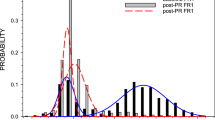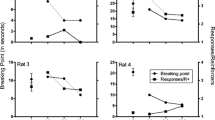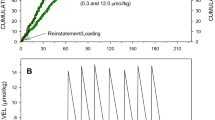Abstract
The present experiments examined whether the rate and type of events maintaining responding help determine physostigmine's behavioral effects. The first two experiments examined the acute and chronic effects of physostigmine, respectively, on lever pressing of rats under variable-interval schedules of food presentation. The third examined the chronic effects of physostigmine on lever pressing under random-interval schedules of shock avoidance. Three different variable intervals (18, 56, and 180 s) and two different random intervals (20 and 60 s) were studied, each associated with a distinctive stimulus. Baseline rates of responding were directly related to the scheduled rate of food delivery or shock avoidance. Acute administration of 0.154–1.233 μmol/kg (0.1–0.8 mg/kg) physostigmine sulfate produced monotonic decreases in overall response rate under all schedules of food presentation. Acute effects (per cent of control response rate) did not differ systematically under the various interval values. Large doses (i.e., 0.4 or 0.8 mg/kg) suppressed the rate of food delivery as well. When initially administered, 0.967 μmol/kg (0.4 mg/kg) physostigmine salicylate also suppressed avoidance response rates and per cent shocks avoided. Tolerance developed to the effects of this dose of physostigmine salicylate on pellet or shock-avoidance frequency more rapidly than to effects on overall response rate. Tolerance to the latter developed only very gradually and could in the case of shock-avoidance response rates be considered partial at best. Tolerance was not affected by the scheduled rate of food or shock presentation. Blood acetylcholinesterase levels showed no recovery during chronic physostigmine. Tolerance is discussed in terms of the reinforcement-loss hypothesis.
Similar content being viewed by others
References
Bignami G, Giardini V (1983) Cholinergic effects: critical treatment-behavior interactions in paroxon tolerance. In: Zbinden G, Cuomo V, Racagni G, Weiss B (eds) Application of behavioral pharmacology in toxicology, Raven Press, New York, pp 141–151.
Branch MN, Nicholson G, Dworkin SI (1977) Punishment-specific effects of pentobarbital: dependency on the type of punisher. J Exp Anal Behav 28:285–293.
Catania AC, Reynolds GS (1968) A quantitative analysis of the responding maintained by interval schedules of reinforcement. J Exp Anal Behav 11:327–383.
Chen C (1968) A study of the alcohol-tolerance effect and an introduction of a new behavioural technique. Psychopharmacologia 12:433–440.
Cornfield PK, Stolerman IP (1978) Behavioral tolerance. In: Blackman DE, Sanger DJ (eds) Contemporary research in behavioral pharmacology. Plenum Press, New York, pp 391–448.
Costa LG, Schwab BW, Murphy SD (1982) Tolerance to anticholinesterase compounds in mammals. Toxicology 25:79–97.
DuBois KP (1965) Low-level organophosphate residues in the diet: their potential hazards. Arch Environ Health 10:837–841.
Elsmore TF (1976) The role of reinforcement loss in tolerance to chronic Δ9 effects on operant behavior of rhesus monkeys. Pharmacol Biochem Behav 5:123–128.
Fleschler M, Hoffman HS (1962) A progression for generating variable-interval schedules. J Exp Anal Behav 5:529–530.
Galbicka G, Branch MN (1981) Selective punishment of interresponse items. J Exp Anal Behav 35:311–322.
Galbicka G, Platt JR (1984) Interresponse-time punishment: a basis for shock-maintained behavior. J Exp Anal Behav 41:291–308.
Galbicka G, Platt JR (1986) Parametric manipulation of interresponse-time contingency independent of reinforcement rate. J Exp Psychol: Anim Behav Proc 12:371–380.
Galbicka G, Lee DM, Branch MN (1980) Schedule-dependent tolerance to behavioral effects of Δ9 when reinforcement frequencies are matched. Pharmacol Biochem Behav 12:85–91.
Giardini V, Meneguez A, Amorico L, de Acetis L, Bignami G (1982) Behaviorally augmented tolerance during chronic cholinesterase reduction by paraoxon. Neurobehav Toxicol Teratol 4:335–345.
Kalant H, LeBlanc AE, Gibbins RJ (1971) Tolerance to, and dependence on, some non-opiate psychotropic drugs. Pharmacol Rev 23:135–191.
Little HJ, Rees JM (1974) Tolerance development to the antinociceptive actions of morphine, amphetamine, physostigmine and 2-aminoindance in the mouse. Experientia 30:930–932.
McKearney JW, Barrett JM (1977) Schedule-controlled behavior and the effects of drugs. In: Blackman DE, Sanger DJ (eds) Contemporary research in behavioral pharmacology. Plenum Press, New York, pp 1–68.
Metcalf DR, Holmes JH (1969) EEG, psychological and neurological alterations in humans with organophosphorous exposure. Ann NY Acad Sci 160:357–365.
Meltzer LT, Rosecrans JA (1982) Tolerance to the disruptive effects of arecoline on schedule-controlled behavior. Psychopharmacology 77:85–93.
Overstreet DH, Dubas G (1978) Tolerance to the behavioural effects of physostigmine in rats: lack of importance of behavioural compensation. Commun Psychopharmacol 2:93–98.
Russell RR, Warburton DM, Segal DS (1969) Behavioral tolerance during chronic changes in the cholinergic system. Commun Behav Biol 4:121–128.
Schuster CR, Dockens WS, Woods JH (1966) Behavioral variables affecting the development of amphetamine tolerance. Psychoparmacologia 9:170–182.
Seigel S (1985) Drug-antcipatory responses in animals. In: White L, Tursky B, Schwartz GE (eds) Placebo: theory, research and mechanisms. Guilford Press, New York, pp 288–305.
Siakotos AN, Filbert M, Hester R (1969) A specific radioisotopic assay for acetylcholinesterase and psuedocholinesterase in brain and plasma. Biochem Med 3:1–12.
Sidman M (1953) Two temporal parameters in the maintenance of avoidance behavior by the white rat. J Comp Physiol Psychol 46:253–261.
Simpson LL (1974) The effects of lithium and physostigmine on rat brain acetylcholinesterase activity. Psychopharmacology 38:145–150.
Snapper AG, Inglis GB (1985) Sked-11 software system. State Systems, Inc, Kalamazoo, MI
de Villiers PA (1972) Reinforcement and response rate interaction in multiple random-interval avoidance schedules. J Exp Anal Behav 18:499–507.
Witkin JM, Barrett JE (1981) Effects of pentobarbital on punished behavior: persistent increases with chronic administration. Psychopharmacology 75:324–325.
Author information
Authors and Affiliations
Additional information
The views of the author(s) do not purport to reflect the position of the Department of the Army or the Department of Defense, (para 4-3, AR 360-5)
Rights and permissions
About this article
Cite this article
Galbicka, G., Elsmore, T.F. & Witkin, J.M. Tolerance to behavioral effects of physostigmine under interval schedules of positive or negative reinforcement. Psychopharmacology 97, 448–455 (1989). https://doi.org/10.1007/BF00439546
Received:
Accepted:
Issue Date:
DOI: https://doi.org/10.1007/BF00439546




